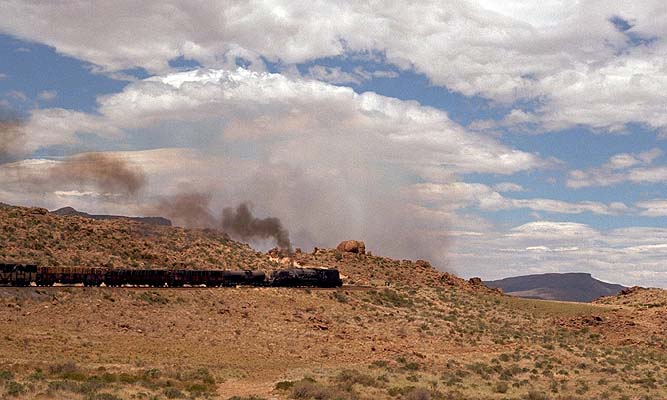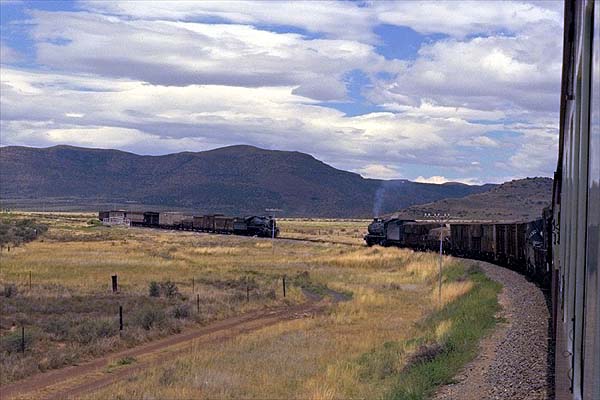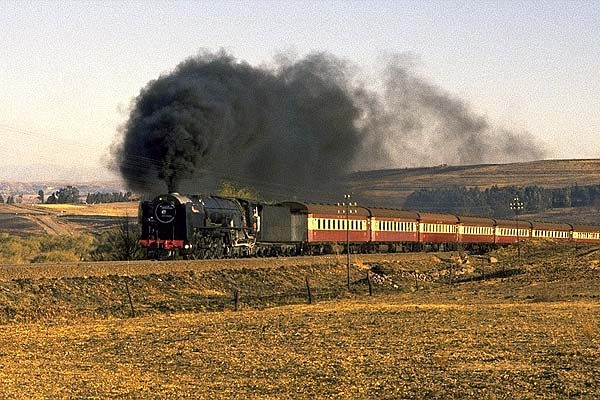|
Case
Notes - Steam in South Africa Part 4 |
|
|
Terry Case writes about his travels for steam. Further tales will follow from time to time covering more of Australia, India, South Africa, Indonesia and Pakistan. Click here for the Case Notes Index. For other tales in this series see:
Leaving Rosmead on 25th January 1977 I was back to travelling in 1st class, and I was the only passenger in the compartment, unlike the previous day it was sheer luxury. An unkempt Burgersdorp 15AR, 2016 provided the power for the mixed which included 2 coaches for whites and blacks. Passing the shed area I saw a GMAM 4053 being prepared, I thought this would be my last view of a SAR Garratt as overseas trips were expensive and seen as “something that some young people did before settling down". I was not of that ilk. Mixed trains had once been common in Australia, but by the time I arrived most had been withdrawn so I was keen to enjoy a form of travel that once had been common. This line was not visually stunning, unlike Lootsberg but leaving Rosmead many steep sided and flat top hills (Kopjes) were to be seen. Apart from stops to collect tokens, the first prolonged stop was at Schoombee where the locomotive took water from a large tank, rather American in style. The locomotive now had to be worked harder, but nothing like the previous day. This pleasant line carried little traffic, only one train was encountered prior to reaching Stormberg in the late afternoon. The timetable showed a cross at Steynsburg, arrive 11.55, however the train was running 70 minutes ahead of the schedule. The cross was made inatead in open country, we drifted downgrade into the loop where 19D 2721, a Queenstown locomotive was ready to go with the opposite mixed. There was no time to dismount as the crew were eager to get on the way, I settled back to observing the countryside.
Crossing the opposite working hauled by 19D.2721.
19D 2721 departs the cross with a mixed to Rosmead.
Later that afternoon the train faced a challenging section as it climbed the grade to Kromhoogte summit that saw the line clinging to a rock face and a vertical exhaust, was testament to hard work on the footplate. Arrival at the junction at Stormberg was well ahead of time. The junction had once been protected by an old British Fort built during the Boer War. The mixed joined the Midland mainline from Queenstown, but our locomotive had first to push its train back and have the points reset, before running through the station area for the short mainline section to Burgersdorp where the mixed was held by signals, before drawing into a crowded yard at 15.35. The humble mixed did not warrant a platform, leaving passengers had to climb over, or duck under wagons to gain the platform. I joined a mainline passenger due at 16.15 to Queenstown, this was the all stations passenger to East London headed by a diesel, the first for my trip.
The train dawdled its way to Queenstown. En route two 15ARs were seen at Moleteno taking water, locomotives numbers 1803 and 1810. (I had seen1803 only a few days before in the Port Elisabeth area). Both locomotives were clean and were working the Burgersdorp freight I intended to ride the following day. 20.00 and its a warm night, after a lengthy stop in a loop a steam whistle is heard, then a yellow headlight penetrates the darkness and flicks to high beam, a light locomotive roared through - whoosh! This was supposed to be narrow gauge, the sound of the steam locomotive hammering away drifted back, the spell is broken when the diesel grumbling comes to life. Next day, Queenstown still had steam pilots and some steam turns, 24 class 3630 departed with the mixed to Drakensfield. Another 24 passed through the station with a freight which I was later to see about 10 miles out, waiting to access a branch line. The morning was overcast and I did not bother to photograph the action, how blasé I had become, steam was an everyday occurrence. Two 15ARs were to work the pick-up freight to Burgersdorp, another van only affair. The freight was used to return locomotives to Burgersdorp after washouts and overhauls at Queenstown. 2097, in poor external condition was lead locomotive, 2100 was clean, its cab controls had been brassed up, and it was decorated; obviously someone looked after this locomotive.
Departure was on time at 09.45, but it was a hesitant start with two lengthy stops before gaining a clear road allowing the locomotives to be opened up and gain some speed. By 10.25 the train was encountering grades that forced both locomotives to be worked hard and the train proceeding at a good rate. Not long after we paused at a small halt and commenced shunting some wagons with p.w. material leaving some wagons and collecting others Alongside the brakevan a gang of African labourers were manually lifting lengths of rail and loading them into wagons, from the ground. Back breaking work without any mechanical assistance. After 25 minutes the train was underway again only to be stopped soon after in another loop to do a cross. Prior to reaching Sterkstroom at 11.30 opposite mixed was crossed running extremely early behind Burgersdorp 15ARs. 19Ds were also exchanged using this train. On arrival at Sterkstroom locomotives were uncoupled and moved forward to a double water column, giving me time to inspect them. In the yard covered by tarps was a steam locomotive, I later discovered this to be 19AR 692 to be preserved here. Meanwhile a triple headed diesel freight roared through. With the line clear the 15ARs our shunted the sidings and collected more wagons. 19Ds were allocated here to work the Maclear branch and a few were in steam.
It was early afternoon 13.05 when the train came to grips with the pass. I thought this was one of the highlights of the trip as the locomotives negotiated the severe curves and made the steep climb, The brakevan provided a wonderful (if somewhat jerky) view of the action. Both locomotives were hard pressed and threw out clag. Rocky outcrops provided an interesting background, South Africa had plenty of scenic vistas. The freight quickly lifted from the valley floor, not the same sharp drops as seen on the Montague Pass, but certainly spectacular. 35 minutes later it was over, it was a brilliant ride. The train continued to climb but on more gradual grade to Moleteno where both locomotives were cut off and took water, 2100 was then used to shunt the yard and nearby sidings, for about two hours. It was delightful to watch this old locomotive going about its work in the afternoon sun. The locomotive had a wonderful crisp bark, the whistle was not the usual pip squeak, but a haunting blast, Baldwin style.
Around 16.00 a 24 class arrived on a short train of box cars from Burgersdorp for the branch, the locomotive had a giant Mickey mouse style logo to the tender side, not the usual thing to be seen on SAR! Following its arrival my train got underway once more, now running close to booked time again. At Stormberg I was surprised to see a double headed 15AR combination on a passenger train from Rosmead hauled by 1784 and another clean locomotive, 2020 named "Tommy”, an unusual name for a locomotive operating in the ex Boer War contested area? This train was possibly the East London train, or a holiday relief working. Arrival in the freight yard at Burgersdorp was at 17.30, after a lengthy wait the train entered the yard, the few passengers scattered from the van. I was left to negotiate my way out of the tangled yard clambering over wagons in 3 different roads before finding the station platform. A couple of 19Ds were on pilot duties. By contrast a 7th class, 1056 with a ridiculously large cab and paraffin headlamp, was preserved on the station lawn. A 15AR arrived on a mixed from Aliwal North. When researching this trip diesels were expected, but steam was still at work. Another clean 15AR with whitened wheel tyres put in an appearance on a freight, not bad action for a diesel mainline. I took the overnight passenger, from East London to Bloemfontein, the next morning I woke to find my carriage in the sidings at Bloemfontein, adjacent to my carriage was a 15 F which had arrived from Thabu Nchu. This passenger link locomotive was a clean locomotive, with white outlining, white rimmed deflectors. Reading my old notes I keep noticing how I was commenting on clean, decorated locomotives, so different than the run down machines that saw the end of standard gauge steam in Aus. My carriage was to be attached to the Bethlehem train, 15F 2948 on yard pilot, ensured no one slept in, as it hurled lengthy carriage rakes in and out of the station, refreshing to hear that bark from its exhaust. Midday at Modderpoort where I had time to inspect the locomotive as it was serviced. This was a terrific location, towering cliffs provided a stunning backdrop. The afternoon saw the locomotive getting stuck in, a good way to finish my brief tour. There was so much I had not seen, especially the narrow gauge, however I saw a remarkable rail network at near its peak, before it was decimated by cut-backs.
|










